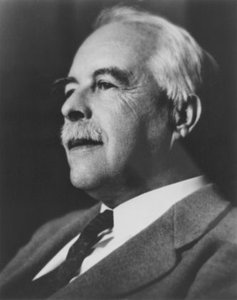
Gilbert Newton Lewis was an American physical chemist and a Dean of the College of Chemistry at University of California, Berkeley. Lewis was best known for his discovery of the covalent bond and his concept of electron pairs; his Lewis dot structures and other contributions to valence bond theory have shaped modern theories of chemical bonding. Lewis successfully contributed to chemical thermodynamics, photochemistry, and isotope separation, and is also known for his concept of acids and bases. Lewis also researched on relativity and quantum physics, and in 1926 he coined the term "photon" for the smallest unit of radiant energy.
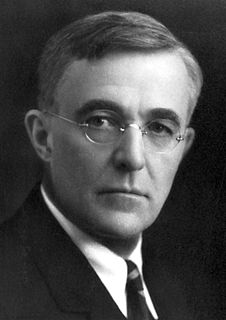
Irving Langmuir was an American chemist, physicist, and engineer. He was awarded the Nobel Prize in Chemistry in 1932 for his work in surface chemistry.
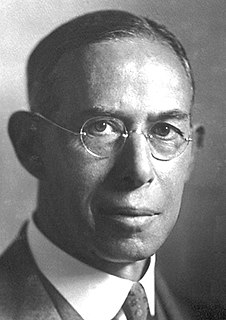
Joseph Erlanger was an American physiologist who is best known for his contributions to the field of neuroscience. Together with Herbert Spencer Gasser, he identified several varieties of nerve fiber and established the relationship between action potential velocity and fiber diameter. They were awarded the Nobel Prize in Physiology or Medicine in 1944 for these achievements.

Katharine Burr Blodgett was an American physicist and chemist known for her work on surface chemistry, in particular her invention of "invisible" or nonreflective glass while working at General Electric. She was the first woman to be awarded a Ph.D. in physics from the University of Cambridge, in 1926.

Sunnyside (1835) is a historic house on 10 acres along the Hudson River, in Tarrytown, New York. It was the home of the American author Washington Irving, best known for his short stories, such as "Rip Van Winkle" (1819) and "The Legend of Sleepy Hollow" (1820).
Rexford is a hamlet in Saratoga County, New York, United States, located on the north bank of the Mohawk River. Rexford is in the Town of Clifton Park, near the southwestern town line. Its boundaries, like those of neighboring Alplaus, are unofficial and necessarily ambiguous. To the south, it is bounded by the Mohawk River and Grooms Road and to the west, Alplaus and the Schenectady County line. Route 146 and Vischer's Ferry Road, are probably a reasonable delineations of its northern and eastern boundaries. The ZIP Code is 12148.
Vincent Joseph Schaefer was an American chemist and meteorologist who developed cloud seeding. On November 13, 1946, while a researcher at the General Electric Research Laboratory, Schaefer modified clouds in the Berkshire Mountains by seeding them with dry ice. While he was self-taught and never completed high school, he was issued 14 patents.
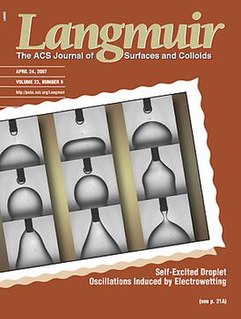
Langmuir is a peer-reviewed scientific journal that was established in 1985 and is published by the American Chemical Society. It is the leading journal focusing on the science and application of systems and materials in which the interface dominates structure and function. Research areas covered include surface and colloid chemistry.
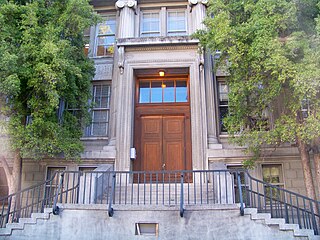
Gilman Hall is a building on the campus of the University of California, Berkeley. Room 307 was where Glenn T. Seaborg and his coworkers identified plutonium as a new element on February 23, 1941 and as such, is designated a National Historic Landmark. The building itself is designated a National Historic Chemical Landmark, recognizing the two Nobel Prizes in Chemistry that have resulted from research done in the building.

The Percy W. Bridgman House is an historic house at 10 Buckingham Place in Cambridge, Massachusetts, United States. It is a National Historic Landmark, notable for its associations with Dr. Percy Williams Bridgman, a physicist, Nobel Prize winner, and Harvard University professor. It is now part of the Buckingham Browne & Nichols (BBN) Lower School campus.

Havemeyer Hall is a historic academic building located in Columbia University in New York City.
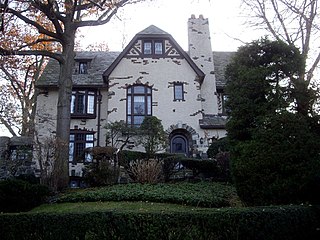
Ralph Johnson Bunche House, the last home of American diplomat Ralph Bunche (1903-1971), is a National Historic Landmark in New York City. It is a single-family home built in 1927 in the neo-Tudor style, and is located at 115-24 Grosvenor Road, Kew Gardens, Queens. It is named after Ralph Bunche, who helped to found the United Nations in 1945. In 1950 he became the first African American and first person of color to win the Nobel Peace Prize, for mediating armistice agreements between Israel and its neighboring countries.

General Electric Research Laboratory was the first industrial research facility in the United States. Established in 1900, the lab was home to the early technological breakthroughs of General Electric and created a research and development environment that set the standard for industrial innovation for years to come. It developed into GE Global Research that now covers an array of technological research, ranging from healthcare to transportation systems, at multiple locations throughout the world. Its campus in Schenectady, New York was designated a National Historic Landmark in 1975.

The Albert Einstein House at 112 Mercer Street in Princeton, Mercer County, New Jersey, United States was the home of Albert Einstein from 1935 until his death in 1955. His second wife Elsa Einstein died in 1936 while living in this house.
William Comings White (1890–1965) was an electrical engineer. He was research assistant to, and cousin of, the Nobel Prize winning chemist Irving Langmuir at the General Electric research laboratory. He was born in Brooklyn and lived most of his life in Schenectady, NY and lived on Lowell Road in the GE Plot.
The Irving Langmuir Prize in Chemical Physics is awarded annually, in even years by the American Chemical Society and in odd years by the American Physical Society. The award is meant to recognize and encourage outstanding interdisciplinary research in chemistry and physics, in the spirit of Irving Langmuir. A nominee must have made an outstanding contribution to chemical physics or physical chemistry within the 10 years preceding the year in which the award is made. The award will be granted without restriction, except that the recipient must be a resident of the United States.

The Theodore W. Richards House is a National Historic Landmark at 15 Follen Street in Cambridge, Massachusetts. Built in 1900, it was the home until his death of Theodore William Richards (1868-1928), the first American to be awarded the Nobel Prize in Chemistry. Richards was a leading experimental chemist of his day, measuring the atomic weights of a large number of elements. He was also responsible for the growth of Harvard University's graduate chemistry program to one of the finest in the nation. The house was designated a National Historic Landmark in 1976.
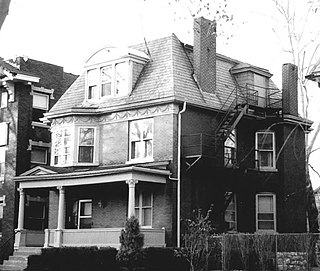
The Joseph Erlanger House is a historic house at 5127 Waterman Boulevard in St. Louis, Missouri. As a National Historic Landmark, it was designated to recognize the achievements of Joseph Erlanger (1874-1965), an American doctor and physiologist, who was awarded with the Nobel Prize in medicine in 1944. It was Erlanger's home from 1917 until his death. It was declared a National Historic Landmark in 1976. However, the house is not open to the public.

The General Electric Realty Plot, often referred to locally as the GE Realty Plot, GE Plots or just The Plot, is a residential neighborhood in Schenectady, New York, United States. It is an area of approximately 90 acres (36 ha) just east of Union College.





















